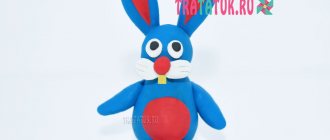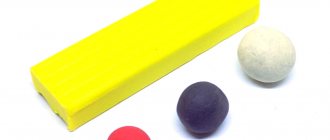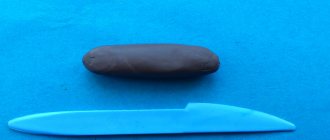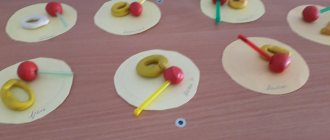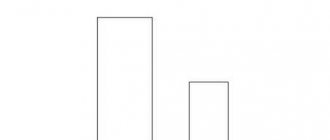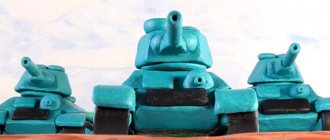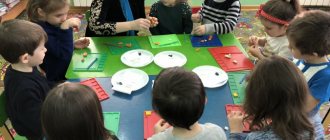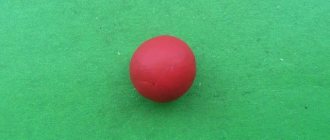Summary of a modeling lesson in the middle group “Dumbbells for Luntik”
Tokpiseva G.V. Summary of a modeling lesson in the middle group “Dumbbells for Luntik” // Sovushka. 2022. N3 (13). URL: https://kssovushka.ru/zhurnal/13/ (access date: 02/05/2022).
Order No. 98431
Goals: continue to develop children's interest in modeling; developing the ability to sculpt from life; To develop in children a desire to engage in sports and physical education; develop fine motor skills of the hands and eye; Cultivate children's interest in modeling sports equipment of their choice.
Vocabulary activation: Sports equipment, jump rope, kettlebell, dumbbells and hoop.
Materials and equipment: plasticine, modeling mass, stacks, napkins,
Preliminary work: conversations about sports and health, looking at illustrations on the topic “A healthy mind in a healthy body,” solving problem situations, practicing behavioral skills when playing sports and physical education. Tactile examination of objects (weights, jump ropes, dumbbells and hoops).
Progress of the lesson:
SMS sound.
Educator: -Guys, we received an email. Do you want to know from whom?
Educator: -Can you read it yourself? Can I read it to you? (picture with letter text)
"Hello. Luntik is writing to you. One day Kuzya and I went for a walk and we saw a berry. We wanted to eat it and look what came out of it:
(Cartoon fragment)
Help: my friends and I want to grow up big and strong, but we don’t know how to become that way. What should we do?"
Educator: Who sent us the letter?
-What do Luntik and Kuzya dream about?
-How to help Luntik and Kuza become big and strong? (play sports, do exercises, etc.)
-Why do you think Luntik and Kuzya couldn’t pick the berry?
-What needs to be done to make your hands strong?
- Look, what do you think this is? (Children express their opinions)
And with the help of what objects do we become strong and healthy? (Children answer - balls, hoops, jump ropes, dumbbells, weights).
- this is Sports equipment - this is what we use to become strong, healthy and resilient.
Now let's look at it
- Let's try to become a little stronger with the help of these items. (Children take turns coming up and trying to jump rope, spin a hoop, lift a weight and dumbbells).
- Well, let's see: have you pumped up your strength?
— Guys, how do you think we can help Luntik? (let’s give him sports equipment).
-Can I donate the sports equipment that we have? Why not?
-Then where can we get the same one, but in a small size? (blind).
-Go to the table and choose what you will use to make sports equipment from.
Independent work of children.
-Luntik lives far away. How can we give him our dumbbells, hoops, jump ropes, balls? (we will send the parcel).
Tell me: what did Luntik ask us for? Do you think we helped him?
Summary of GCD for modeling
Summary of GCD in the middle group “Journey to the land of health” Modeling + Cognition (integration of OO) Summary of GCD in the middle group “Journey to the land of health” Modeling + Cognition (integration of OO)
Summary of GCD in the middle group
“Journey to the Land of Health” Modeling + Cognition (OO integration)
Educational areas: artistic creativity (sculpting, safety, cognition
Tasks:
— To develop children’s ability to properly care for their teeth, to explain to children why it is necessary to take care of their teeth from childhood;
— Clarify children’s ideas about healthy and proper nutrition, give ideas that foods can be healthy and harmful for teeth;
— Strengthen children’s ability to sculpt round and elongated objects.
— Cultivate a desire to take care of your health.
— Develop children’s speech, attention, thinking.
Equipment.
Toothbrush, paste, illustrations of teeth (“cheerful” and “sad”, pictures “Harm to teeth”, pictures of vegetables and fruits, plasticine for each child, modeling boards, napkins, small pictures of a cheerful and sad tooth (by number children, 2 toy plates.
Progress of the lesson.
Org. moment. Children sit on chairs in a semicircle.
Q. Guys, we have guests today. Let's say hello to them! (children say hello). I suggest you get ready for work. Repeat with me.
Hello, golden sun! (reached up)
Hello, blue sky! (hands spread)
Hello, free breeze! (shaked hands)
Hello little sprout! (crouched down, hands down to the ground)
Hello, my dear friend! (extend hands to neighbor).
Motivational stage. Updating knowledge.
Q. Guys, do you like to travel? Have you ever been to the land of health? Today we will go to the land of health. You are ready? Get on the train. Let's hit the road! The Blue Carriage music plays, children move around the group to the music. The teacher of the first trailer is the helmsman. “Choo-choo! » They approach the table, on which there is a toothbrush and toothpaste under a cape.
V. This is the first stop. There's something here, let's see. What is this? Points to the toothbrush. Why is it needed? And what's that? Shows toothpaste. Do you know how to brush your teeth? Let's brush our teeth.
Articulation gymnastics “Brushing your teeth” (picture)
Kitty Muzik got up in the morning and smiled
I ran to brush my teeth. open your mouth
Right-left, right-left, “clean” with the tip of your tongue from the inside
We brush our teeth skillfully. alternately lower and upper teeth 5-6 times
Let's rinse your mouth
Like a neat cat. "rinse your mouth"
Q. What great guys you all are, you know how to brush your teeth. Now let's move on.
To the music, the children move further in the group to the chairs.
Q. Here's the next stop. Sit down on the chairs.
Illustrations of “happy” and “sad” teeth are displayed on the easel.
B. Look at the illustration. What is this? Why is he smiling? Yes, he is cheerful because he is healthy. The teacher shows an illustration of a sad tooth.
Q. What happened to this tooth? Why is he so sad? Why can a tooth get sick? The pictures will help you. (children take turns speaking, chewing nuts with their teeth, picking their teeth, eating sweets, not going to the doctor, not brushing their teeth)
Guys, not every food is good for our teeth. Now we will play with you.
Game “What is useful and what is harmful”
I will tell you the words - food. If it is good for your teeth, clap your hands; if it is harmful, stomp your feet. (carrots, beets, cabbage, cucumber, tomato, apple, pear, chips, candies, chocolates, hot tea, ice cream, milk, cheese)
Outdoor game "In an even circle"
Rules of the game:
Children stand in a circle. In the middle of the circle is a child playing the role of soap. Children walk one after another in a circle, singing a song:
In an even circle, one after another, We will walk merrily, Whatever the soap shows us here, That’s what we will do.
Soap shows how to soap your hands, the children repeat the movements. Then the corresponding movement shows a towel (comb, toothbrush, washcloth, handkerchief).
Practical stage.
Q: Guys, let's blind it, and guess what.
The tail is made of bone and there are bristles on the back.
(Children sculpt while standing at the tables; calm music sounds while sculpting).
First, let's prepare the fingers.
Finger gymnastics
Self-massage:
“My, my chimney sweep - rubbing the palms Clean, clean, clean, clean! - stroking the face Will, will, chimney sweep - circular stroking of the belly Clean, clean, clean, clean!” - tapping feet with fists.
Our fingers are ready. Choose what you will sculpt, select the color of the plasticine. The pictures on the board are helpers. Don't forget to warm up the plasticine. (independent work, musical accompaniment). Dry your hands with tissues.
Bottom line. Reflection.
Place your fruits and vegetables on plates.
We'll show them to our parents and our guests will watch them. And you and I will go to the mat. Those who liked the lesson, those who learned a lot, choose a happy tooth, those who were not interested and didn’t learn anything, choose a sad tooth. And it was interesting for me to work with you, you worked hard today, I’ll choose a funny tooth. Thanks for the work! Author: Zharkova Ella Yurievna
Progress of the lesson
Read the Bulgarian song “Forest Outfit” to the children:
The forest did not spin in winter, did not weave, stood idle, but the snow melted, and the stream began to sing - the forest dressed itself in green silk!
Invite the children to make a spring forest dressed in green silk.
Children are divided into subgroups of 4–5 people and distribute the work among themselves. Someone will roll small green balls from plasticine, attach them to a dried grape branch, slightly flattening them - these will be leaves on the trees.
Another child will paint over pine cones with green gouache to create Christmas trees. Someone will use plasticine to attach trees, fir trees, and moss in the form of grass to a cardboard cover. Someone will sculpt the first flowers: snowdrops, primroses, lilies of the valley, coltsfoot. You can sculpt a stump from plasticine.
At the end of the lesson, the children of each subgroup talk about their spring forest; Interesting findings are discussed and unexpected solutions are noted.
Lesson 28. Cheerful gnome (Modeling from plasticine in combination with natural materials)
Program content. Continue to teach children to combine natural material (pine cone) and plasticine in crafts; convey the proportional relationship of the parts of the figure. Strengthen the ability to connect parts of a product using plasticine, smoothing the joints. Develop imagination and imagination when bringing the product to the intended image. Strengthen the ability to understand and analyze the content of a poem.
Material. Pine cones, tree branches and other natural materials, plasticine, cardboard stands, boards (for each child).
Progress of the lesson
Read the poem by G. Lagzdyn to the children:
We are in a hurry. At the appointed hour, the Good Home meets us. Here are your favorite toys, Here are your friends, And here are your girlfriends. I'm going, I'm going, I'm leading my younger brother. I undress on the go - We have a lot to do in the garden!
Ask the children: “Why is the girl in such a hurry to go to kindergarten?” (She has a lot to do in the garden; her favorite toys, friends and girlfriends are waiting for her there.)
Talk to the children about their friends in the garden. Invite each child to model one of their friends out of plasticine. Draw the children's attention to the fact that the sculpted figures should be approximately the same size so that they can be combined into a common composition at the end of the lesson.
Explain the sequence of work: if you are making a figure of a boy, you need to separate a large piece of plasticine with a stack, roll it into a thick roller, cut one end with the stack into two equal halves (these will be the legs) and bend the small feet-stands forward. Separately sculpt a head in the form of a ball, arms in the form of columns and attach them to the top of the roller. To sculpt a girl, you need to roll a thick cylinder between your palms and narrow it on one side to form a truncated cone. The head and arms are sculpted in the same way as for the boy figurine.
Then you need to figure out what the girl (boy) is doing and give the figure the appropriate position. Using stacks and plasticine, add expressiveness to the image and convey the characteristic features of your friend in the sculpting. You can fashion attributes - give them a ball, a stick, candy; sit on a chair, etc.
At the end of the lesson, all the figures sculpted by the children are combined into a common composition.
"If you want to be healthy..."
Summary of a lesson in modeling (in the middle group)
"If you want to be healthy..."
Educational task
:
Formation of the ability to experiment and create simple images from plasticine, the ability to independently convey images of objects using available visual means (in particular plasticine);
Teach children to sculpt sports equipment in a constructive way. To form children’s initial ideas about sports equipment.
Developmental task:
Develop shaping abilities using plasticine; To develop in children the ability to properly engage in sports and physical education;
Develop fine motor skills of the hands, eye, coordination in hand movements;
Educational task:
Cultivate children's interest in modeling sports equipment of their choice.
Materials and equipment: red, yellow and black plasticine, stacks, napkins, pictures for viewing on the theme “Health” and “Sports”, pre-made figures (weight, jump rope, dumbbells and hoop).
Progress of the lesson:
Educator:
Guys, today a bear cub came to visit us, whose name is Tishka. Let's say hello to him. (Children greet the bear by the paw). He is still small and not very strong. And for him to become strong, what does he need to do? (Children answer: Do exercises, play sports, etc.)
Educator:
Tishka Bear, why are your hands so weak?
Bear: Because, guys, I don’t eat much porridge and don’t drink milk at all.
Educator:
Do you want to have weak hands too? (No) What should you and I do to be strong and eat well? (Do physical education). Look at the dumbbells lying here. They are heavy. What can we do with their help? (pump up strength). What color are they? (Yellow, red). Tishka, look at what children can do to become strong and resilient. (Physical minute to the music “Everyone around is trying to play sports”)
Bear: Children, tell me, what sports do you know? (Children answer)
Educator:
Guys, do you like physical education? (Yes). And with the help of what objects do we become strong and healthy?
(Children answer - balls, hoops, jump ropes, dumbbells, gymnastic walls). What do you think it is? (Children express their opinions)
— Sports equipment is what helps us become strong, healthy and resilient. Let's remember once again what applies to sports equipment? (Children answer).
- Now let's look at it. Let's look at the weight. What is she like? (the heaviest). (Children look at a kettlebell, a hoop, dumbbells and a jump rope).
- Let's try to become a little stronger with the help of these items. (Children take turns coming up and trying to jump rope, spin a hoop, lift a weight and dumbbells).
— Guys, what will happen if Tishka bear uses dumbbells incorrectly? (Children answer)
-Well done! Absolutely right! If you handle these items incorrectly, you can get hurt or drop a weight or dumbbells on your own or a friend's leg. Therefore, such exercises should only be performed with adults!
“Children, let’s make a jump rope, a weight, dumbbells and a hoop for Tishka.”
— Girls, what sports equipment do you like best? (jump ropes and hoop).
- Boys! And you? (weights, dumbbells).
(The teacher invites two girls to demonstrate how they jump rope and twirl a hoop, and for the boys to demonstrate how to lift a weight and dumbbells, Tishka the bear helps them)
- Well done!
- Now let's get to work. Girls will make jump ropes and hoops, and boys will make weights and dumbbells. (The teacher demonstrates how to sculpt dumbbells, a jump rope, a kettlebell, a hoop. Children choose the color of plasticine and begin to sculpt sports equipment).
- Girls, I prepared some threads for your rolling pins. You only need to make two cylinders for the handles.
(Children make the rest of the sports equipment as shown by the teacher).
- Well, children. You and I have worked hard today. What have we made? (Children's answers).
Bear: Oh, guys, I really liked it with you. I became much stronger and really wanted to eat porridge and drink milk. Well, that's it, I ran. Goodbye! See you again!
- Bye! Bye! (Children say goodbye to Tishka the bear).
Educator:
Today in class we learned what sports equipment is, how you can work with it, what it is needed for. Guys, why can’t you play with sports equipment? What will you tell your family and friends about health, about how to become strong and resilient. (Children's answers).
Progress of the lesson
Start your lesson with finger exercises:
Our delicate flowers (The fingertips of the two palms are connected.) Open their petals. (Smooth opening of fingers.) The breeze breathes slightly, the petals sway. (Swinging with open palms.) Our scarlet flowers close their petals. (Smooth connection of fingers.) They quietly fall asleep, shaking their heads. (Folded palms lean against one ear, head bowed.)
Invite the children to fashion a flower in a pot.
The pot can be made from plasticine rings that fit tightly together or made from a plasticine ball by making a hole with your finger. Black earth (plasticine) is “poured” inside the pot. Children come up with the shape of the flowers themselves.
